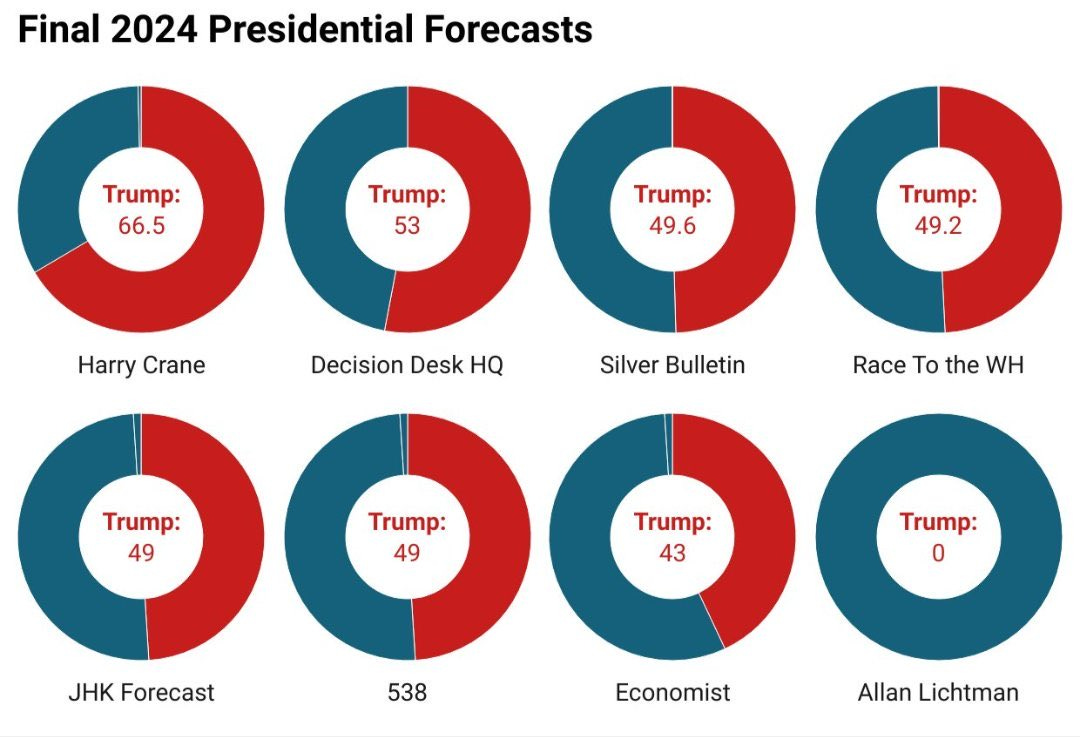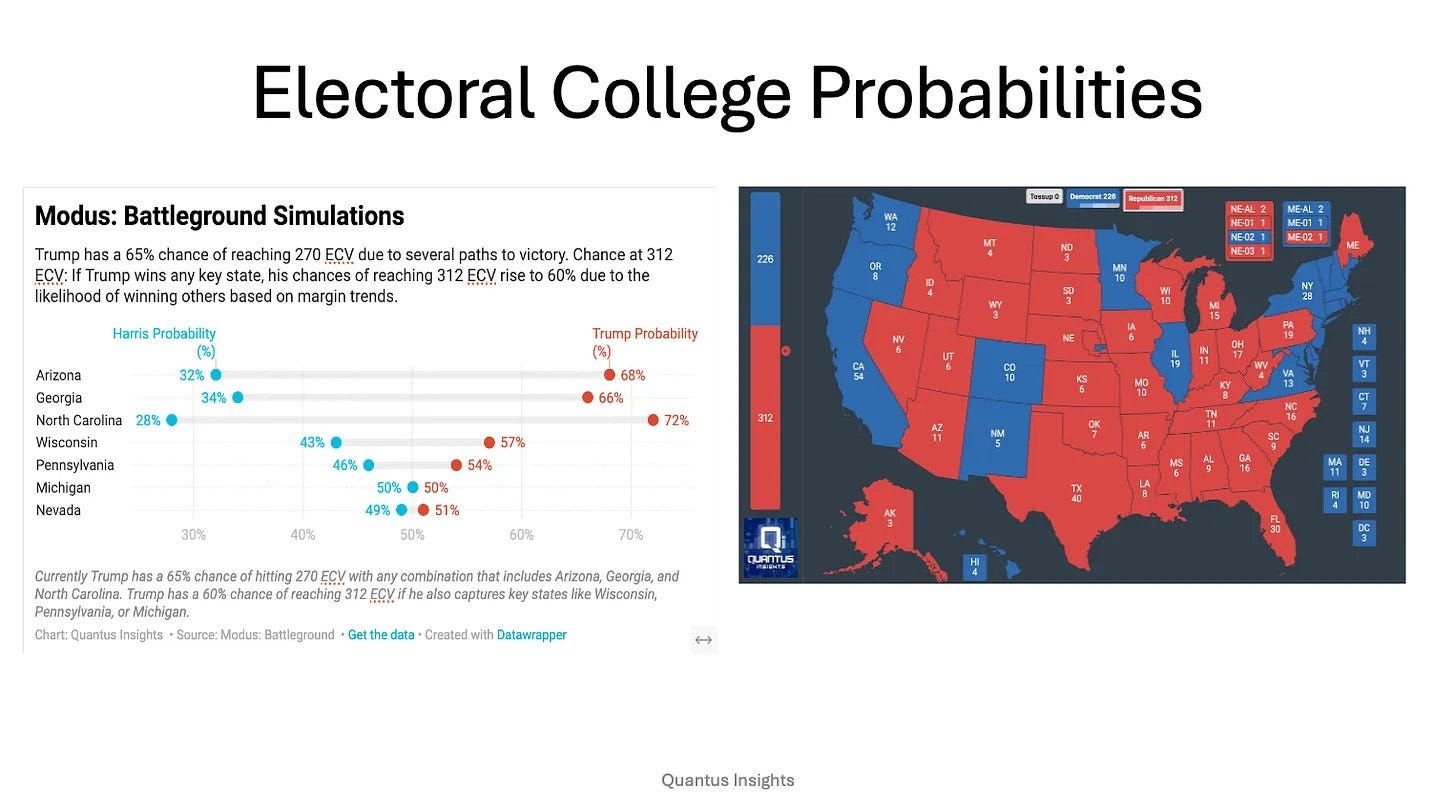Quantus Insights: 2024 Election Forecasting and Polling Performance Review
Setting the Standard: Industry-Leading Accuracy in 2024 Election Forecasting
Quantus Insights: 2024 Election Forecasting and Polling Performance Review
In the 2024 presidential election, Quantus Insights distinguished itself with a highly accurate forecast, successfully projecting Donald Trump's victory over Kamala Harris with a final count of 312 electoral votes to Harris' 226. Our models and polling both demonstrated notable precision, solidifying Quantus Insights as an industry leader in election analysis. As the final vote tallies are completed, we anticipate our projections to be within a point of Trump’s actual finish, while Harris’ percentage aligns almost exactly with our forecasts.
We project Trump to finish with 49.9% to 50% of the national popular vote, while Harris will finish with 48.3% to 48.4%. Our combined weighted election models projected Trump at 48.8% and Harris at 48.4%.
Here’s a closer look at the accuracy of our models and polling efforts, along with how we compared to other forecasters.
Model Performance: A Comprehensive and Accurate Forecast
Quantus Insights’ modeling approach integrated four major components:
Quantus Insights’ modeling approach integrated five major components:
Electorate Model
Purpose: Provides a demographic foundation by simulating turnout and preferences across key population segments.
Description: This model analyzes voter demographics—such as age, gender, race, and education—aligned with historical turnout patterns and preferences. Focusing on stable indicators, it accurately captures baseline electorate makeup, offering insights into turnout-driven shifts that may be less visible in day-to-day polling.
Advantage: The model’s focus on stable demographic trends reduces the noise from volatile polling, providing a consistent view of the electorate.Modus Model (Voter Sentiment)
Purpose: Captures underlying voter attitudes and sentiments, focusing on the psychological and emotional factors driving support or disapproval for each candidate.
Description: Using data from approval ratings, favorability polls, and sentiment indicators, this model translates voter sentiment into electoral support likelihood, adapting to shifts in public opinion throughout the campaign.
Advantage: Its adaptability to real-time events and perceptions is valuable for tracking momentum shifts, especially in close races.Consensus Model (Economic Sentiment)
Purpose: Evaluates economic influence on the electorate by translating economic indicators into voter preferences.
Description: This model aggregates data such as the Consumer Confidence Index (CCI) and Misery Index, aligning voter optimism or concern with voting behavior. It’s particularly useful for assessing how economic conditions impact swing voters.
Advantage: The model’s focus on economic sentiment captures how economic satisfaction or anxiety can sway undecided or swing voters.Polling Model (Weighted Polls)
Purpose: Offers a direct snapshot of voter support through a weighted aggregation of recent polls.
Description: This model averages multiple polling sources, weighting them based on reliability, sample size, and recency. It minimizes outliers to provide stable, representative data, adjusting for polling biases and variations.
Advantage: The Polling Model captures short-term shifts and public reactions, giving a daily pulse on voter intention.Concordia Model (Probabilities Model)
Purpose: Converts model outputs into a winning probability for each candidate, using historical benchmarks and specific election cycle factors.
Description: The Concordia Model leverages a composite score based on historical data, approval ratings, economic sentiment, and relative polling strength. Positioned along an “S-curve” of likely outcomes, it highlights whether an election leans competitive or decisive.
Advantage: By translating complex variables into an accessible probability, Concordia provides an intuitive summary of win likelihood, effectively quantifying uncertainty.
Integrating Models for Enhanced Accuracy
Quantus Insights’ Combined Models Probability synthesizes these components, weighting them to reflect their relative importance in the current electoral context. This approach allows us to leverage the demographic stability of the Electorate Model, the adaptability of Modus, the economy-driven insights from Consensus, and the real-time pulse from Polling. By adjusting the weight of each model based on context, we capture a nuanced forecast that adapts as the election environment evolves, making it particularly suited to capturing shifts in battleground states.
This multi-faceted framework consistently reflected a Trump advantage from September 1, maintaining this trend as the race unfolded. Our models demonstrated strength at the state level, particularly in accurately predicting Trump’s victories in key battlegrounds like Nevada and North Carolina as early as September.
Setting the Standard: Industry-Leading Accuracy in 2024 Election Modeling
Quantus Insights’ Combined Models Probability synthesizes these components, weighting them to reflect their relative importance in the 2024 context. This integration allowed us to leverage the demographic stability of the Electorate Model, the adaptability of Modus, the economic insights from Consensus, and the real-time pulse from Polling. The result was a nuanced, flexible forecast that consistently reflected a Trump advantage from September 1 onward.
Comparison with Other Industry Models
Our forecast accuracy was notable compared to other election forecasters. Quantus Insights projected a Trump win early and maintained this position with consistency, while other major models showed caution or ambiguity:
Harry Crane assigned Trump a 66.5% chance of winning, the highest among forecasters.
Decision Desk HQ estimated Trump’s odds at 53%.
Silver Bulletin and Race to the WH showed a 50% forecast, predicting a closer contest.
538 and Economist assigned Trump only 49% and 43% odds, respectively, while Allan Lichtman showed no expectation of a Trump win.
JL Partners gave Trump a 54% chance, down from 69% just a week before Election Day.
Quantus Insights’ ability to maintain a clear prediction of a Trump advantage, even as other models and the betting markets fluctuated, underscores the strength of our approach. Integrating demographic, economic, and voter sentiment data provided a stable forecast above industry averages, demonstrating our models’ unique reliability and consistency. Our clear modeling advantage in competitive regions, backed by early and stable state-level forecasts, demonstrated the reliability and precision of our multi-layered framework.
Polling Accuracy: Precision in Key States and the National Vote
Quantus Insights’ polling further validated our approach, accurately gauging voter sentiment across national and state levels. Our final national survey (October 27-30) found Trump at 49.1% and Harris at 48.3%. Once the final votes are reported, we anticipate being within a single point of Trump’s national popular vote and nearly exact finish for Harris, positioning Quantus Insights as one of the most accurate polling firms of 2024.
In swing states, our polling reflected Trump’s momentum with high precision. In the Rust Belt—where voter shifts were critical—our average error rate was just 0.55%, perhaps the the lowest in the industry. For example, our final poll in Pennsylvania showed Trump leading Harris by 2.1% (Trump 50.3% to Harris 48.2%), matching the final margin exactly, with a combined top-line finish error of just 0.4%.
Final Assessment: Leading the Field in Forecasting and Polling
Quantus Insights’ success in election modeling and polling for the 2024 election highlights the effectiveness of a multi-layered, data-driven approach. By accurately forecasting each state and nearly perfecting the national popular vote projection, we outperformed many major forecasters, establishing Quantus Insights as a leader in political analysis.
This cycle demonstrates the strength of our approach, which adapts to shifts in voter sentiment, demographics, and economic conditions. Moving forward, Quantus Insights will continue to refine our models, ensuring we remain at the forefront of election forecasting.
Looking Ahead: Quantus Insights’ Expertise for Future Election Cycles
Quantus Insights’ success in 2024 underscores the effectiveness of our multi-layered methodology. As we refine our models, we offer campaigns, media outlets, and organizations tools to gain real-time insights into voter behavior and trends. From polling to demographic and economic sentiment analysis, we provide a comprehensive view of the electoral landscape.
For those aiming to optimize campaign strategies, Quantus Insights delivers customized polling and analytics solutions. Our expertise extends beyond predictions; we provide actionable insights to inform decision-making and shape impactful strategies. Connect with Quantus Insights to leverage the data-driven insights behind our 2024 success and stay ahead in the political arena.
You can vistit our website at QuantusInsights.org.
Quantus Insights is a reader-supported publication. To receive new posts and support my work, consider becoming a free or paid subscriber.






